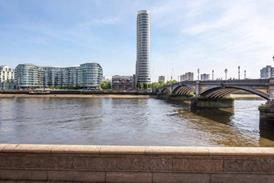Following in the wake of Keir Starmer’s criticism of Britain’s over-reliance on quangos, long-time ARB critic Ian Salisbury argues that the architects’ regulator has overstepped its role and needs to go

When the prime minister recently called out the UK’s bloated quango culture, he could have had the Architects Registration Board (ARB) in mind. Created in 1997 as the keeper of a statutory register, the ARB now claims to “protect the public” and maintain standards in the profession.
But in my view, it is not effective at either and actively hinders the advancement of British architecture. It is high time the Architects Act was repealed and, with it, the ARB abolished.
A legacy of protectionism, not public interest
The roots of statutory registration stretch back to the 1930s, when it was introduced not to protect consumers but to ensure British architects, rather than locally trained professionals, secured imperial contracts. That colonial mindset should have died along with the empire.
Yet the ARB continues to exist. It is a legacy organisation that is forced to pump up its reputation with constant and, it must be said, rather creepy big-brother self-justification.
Originally, the board included elected architects, at least ensuring that some professional representation and a check on its unlawful activities. But today, even those architects on the board are government appointees. This means the profession now has no real say in how it is regulated.
Worse still, the ARB has gone far beyond its legal remit, inflating its role, imposing pointless bureaucracy.
The costly, overreaching bureaucracy of ARB
The ARB’s creeping self-importance is nowhere more evident than in its recent CPD (continuous professional development) scheme. The Architects Act never granted the ARB the power to mandate CPD, yet it has ploughed ahead regardless, twisting legal language to justify its overreach. In doing so, it has ignored the clear wording of the Architects Act which allows architects to choose between recent practice and training, or a combination of both.
Instead, it is forcing compliance through an expensive and unnecessary scheme that benefits not the profession, but commercial enterprises eager to sell their products. Some of these are no more than glorified marketing exercises under the guise of “professional development”.
The first chair of the ARB openly stated that the board needed a “wider remit”. But the law governing public corporations, established in Victorian railway cases, is clear: “What is not permitted is prohibited.” The ARB’s expansion into CPD enforcement appears legally questionable and has the hallmarks of regulatory overreach.
The damage to architectural education
The ARB’s education policies have also come under fire. Its approach has homogenised the profession, stifling the diversity of architectural schools.
In the past, different schools had distinct leanings: some focusing on technical innovation, others on pure design. Now, under the ARB’s narrow framework, that variety has been eroded.
Architectural education thrives when institutions have the freedom to experiment, innovate and challenge conventional wisdom: not when they are dictated to by an unaccountable regulator.
Decisions about qualification approvals are taken behind closed doors, often by individuals with little understanding of education or architectural practice. The result? Confusion, inefficiency and a profession weighed down by red tape and uncertainty.
What have we learnt from Grenfell?
The Grenfell Tower disaster led to two major inquiries, exposing systemic failures in fire safety regulations, materials testing and construction oversight. The resulting reports led to significant legislative changes, including the Building Safety Act and new fire safety regulations. Yet, despite this regulatory tightening, failures in implementation and enforcement persist.
One striking lesson from Grenfell is that no amount of regulation prevents malpractice when commercial and political pressures undermine good practice. The ARB, for all its claims to safeguard the public, had no role in highlighting these issues before the tragedy and, in my view, played a minimal part in addressing them afterwards.
It did not champion the need for statutory or regulatory reform, nor could it have intervened in the deceitful practices that beset the industry, because safeguarding against such failures was never part of its role. This only reinforces the argument that the ARB is powerless in the areas where protection is most needed.
This is the stark reality: real consumer protection comes from accountability and transparency, not from a self-perpetuating quango concerned with professional title protection.
The case against registration
No other construction professionals – engineers, project managers, quantity surveyors – require statutory registration. Their competence is upheld through professional bodies and market forces, not a government-imposed monopoly. And, in several European countries including Denmark, Sweden and Finland, architects operate without statutory registration; yet their built environment is among the best in the world.
Registration does not improve architectural standards, nor does it protect the public. If it did, then we would see higher architectural quality in the UK than is the case in non-registration countries.
We do not. The reality is that registration is an anti-competitive relic, shielding the profession from wider talent and innovation while providing no effective consumer protection.
Monopoly and stagnation
The ARB’s control over the title “architect” discourages competition. Instead of fostering excellence, it protects mediocrity. Small practitioners, in particular, cling to it as a shield against competition rather than a badge of professional achievement.
If title protection disappeared tomorrow, the public would still know where to find competent professionals: through reputation, professional standing and membership of respected bodies such as the RIBA.
Moreover, the ARB’s disciplinary procedures are deeply flawed. The process is slow, unfair and, in some cases, vindictive: offering no recourse against vexatious complaints. The cost of these proceedings is borne by all registered architects through ever-increasing fees. According to its own accounts, ARB’s own legal expenses have spiralled out of control, far outpacing inflation – and all to sustain an inefficient, redundant system.
Who polices the policemen?
A regulator that claims to act in the public interest should itself be subject to scrutiny, yet the ARB has long operated in a legal grey area, shielded from external oversight. Unlike other statutory bodies, it is not subject to review by the parliamentary ombudsman: an omission that raises fundamental questions: Why should architects be accountable to the ARB when the ARB itself is accountable to no one but its own closed system?
If it is to exist at all, should it not be subject to the same external scrutiny that applies to other public bodies? The absence of such oversight only reinforces the argument that the ARB serves itself more than the public.
Freedom to create
At its heart, architecture is a glorious combination of art and science. Architects should be free to push boundaries, explore new materials and create buildings that inspire and delight. While ethical considerations must always ensure safety and sustainability, over-regulation kills creativity.
Some of the greatest architectural achievements have come from risk-takers and visionaries who might never have flourished under today’s restrictive regime. Alas, we see less innovation from architects: it is engineers that are ascendent.
In the Scandinavian model, architects are trusted to practise freely, accountable to their peers and clients, not to a faceless quango. The UK’s architects deserve the same freedom: to compete, innovate and define their profession on their own terms.
A better way forward
If the ARB vanished tomorrow, the profession would not collapse; far from it. Architectural standards would still be upheld through the RIBA and other professional bodies, just as they are in unregulated professions.
Clients already have legal protections through contract law, statutes, technical regulations and standards, consumer rights legislation and the courts.
The government’s own Better Regulation Executive (BRE) now leads efforts to reduce unnecessary regulation. The ARB is a prime example of an organisation that exists only to justify its own existence. It does nothing that could not be done (and has been done) better by a member-led professional body.
Time for change
Starmer’s remarks about “checkers and blockers” should be a wake-up call. The ARB embodies everything that is wrong with regulatory overreach in Britain. It is a costly, restrictive, unnecessary bureaucracy that serves neither the profession nor the public.
The solution is simple: repeal the Architects Act, abolish the ARB and give architects the freedom to compete, innovate and thrive in an open market. Architecture flourishes through creativity and expertise, not through bloated quangos and pointless red tape. The time for change is now.
>> Also read: Architects must do annual CPD to stay on register under ARB plans
>> Also read: Tomorrow’s architects: why we’re consulting on the biggest education reforms in 50 years
Postscript
Ian Salisbury is director of Ian Salisbury Ltd. He is a chartered architect and RIBA client adviser, with experience in dispute resolution as a chartered arbitrator, accredited adjudicator, mediator and expert witness. He is a former board member of the ARB.
















2 Readers' comments